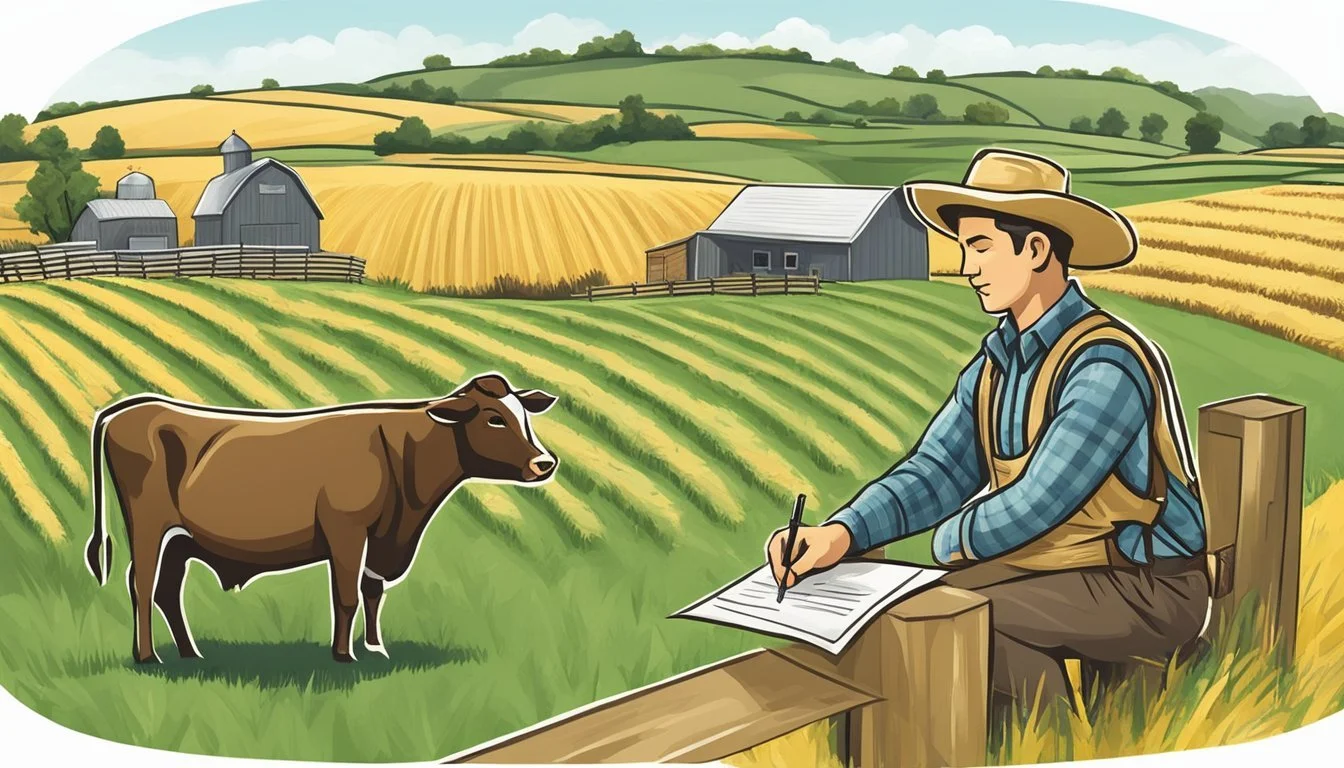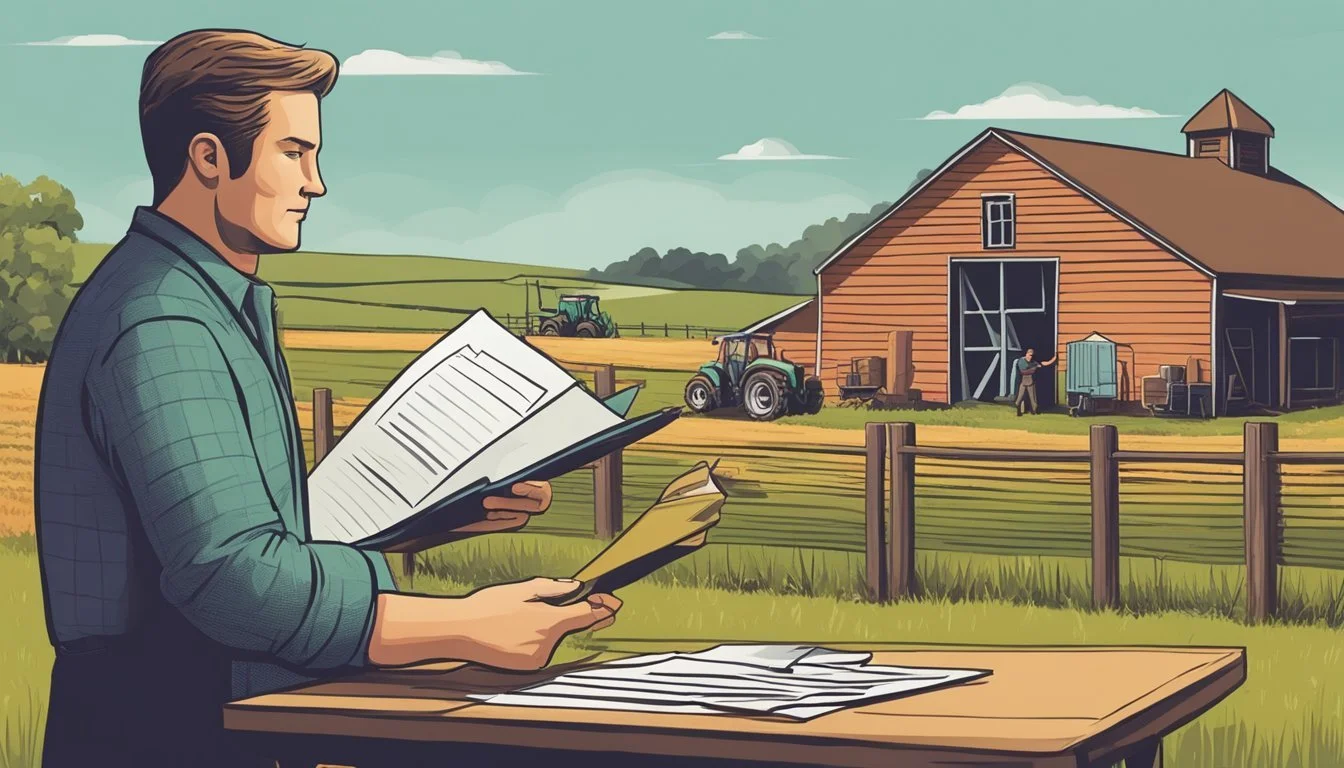Farm Loans in Missouri
Navigating Options and Opportunities
This Article is Part of Our Guide on Farm Loans for All 50 U.S. States
Access to capital is a critical aspect of establishing a successful farming operation, and in Missouri, there are various programs designed to assist farmers in securing necessary funds. The Beginning Farmer Loan Program offered by the Missouri Department of Agriculture, for instance, allows qualified borrowers to obtain up to $649,400 to invest in agricultural land, farm buildings, equipment, and breeding livestock. This initiative aims to support the growth and sustainability of the agricultural sector by making financial resources more accessible to those starting out in farming.
In addition to state-supported programs, local financial institutions like FCS Financial and The Bank of Missouri play a significant role in providing tailored loan options that meet the unique needs of the agricultural community. Whether farmers are looking to purchase land, invest in property improvements, or cover operating expenses, these lenders have a suite of services designed for both the seasoned and the new farmer. They understand that farming is not just a business, but a way of life that requires flexible and reliable financial support to thrive.
Furthermore, federal resources, such as those from the United States Department of Agriculture (USDA) Farm Service Agency, complement state and private lending options. The USDA offerings include farm ownership loans, operating loans, and microloans, catering to a variety of financial needs, from land access to covering day-to-day operational costs. Such a comprehensive network of financial support underscores Missouri's commitment to fostering an environment where farmers and ranchers can succeed.
Understanding Farm Loans
Farm loans in Missouri are integral to the growth and sustainability of the agricultural sector. They provide a financial foundation for farmers to access land, equipment, and resources necessary for farming operations.
Essential Farm Loan Types
There are several key types of farm loans available to Missouri farmers. The two primary categories are ownership loans and operating loans. Ownership loans are used for purchasing land, farm buildings, and making improvements to property, while operating loans cater to day-to-day expenses, equipment, and refinancing debt. In Missouri, qualified borrowers might access loans up to $649,400 to purchase agricultural land, with certain limits on depreciable property.
Roles of Federal and State Agencies
Federal and state agencies play a pivotal role in agricultural financing. Notably, the USDA Farm Service Agency (FSA) offers various loan programs for farmers, including direct and guaranteed farm ownership loans with maximum amounts of up to $600,000. At the state level, the Missouri Agricultural and Small Business Development Authority (MASBDA) has initiatives like the Beginning Farmer Loan Program to facilitate the entry of new farmers into agriculture.
Qualifying for a Farm Loan
To qualify for a farm loan in Missouri, applicants must meet certain criteria. This typically includes demonstrating sufficient farming experience, having an acceptable credit history, and providing a solid business plan. Limits on used depreciable property for some loans, such as those from MASBDA, restrict borrowing to $62,500, intending to support the development of the farming operation without over-leveraging new farmers.
Beginning Farmers and Ranchers
Missouri offers robust assistance programs aimed at supporting beginning farmers and ranchers as they embark on establishing their farming operations. These programs provide financial aid and technical assistance to ensure a strong foundation for the future of agriculture in the state.
Programs and Support for New Entrants
The Missouri Department of Agriculture administers the Beginning Farmer Loan Program. This initiative aids beginning farmers in securing loans with lower interest rates, facilitated by lenders receiving federally tax-exempt interest on these loans. Eligible beginning farmers can receive up to $649,400 to purchase land, equipment, or livestock.
The USDA Farm Service Agency also extends a helping hand to new farmers with its own suite of loans tailored for those who haven't operated a farm for more than 10 years and do not own significant acreage. The eligibility criteria maintained by the agency ensure that more newcomers have access to necessary capital.
Navigating Credit for Newcomers
The prospect of navigating credit can be daunting for new farmers. However, resources such as Farmers.gov offer comprehensive guidance. This online portal serves as a single point of access for USDA resources, providing personalized assistance in understanding loan eligibility requirements for borrowers. It also hosts informational events such as Q&A sessions to further support beginning farmers and ranchers in their endeavors.
Loan Application Process
When applying for a farm loan in Missouri, the applicant must provide comprehensive financial documentation and understand the specific criteria for approval. Lenders and the Missouri Department of Agriculture have established clear steps and requirements for this process.
Preparing Financial Documentation
A critical initial step in the loan application process is the assembly of financial documents. These documents are fundamental for lenders to analyze the suitability and risk associated with lending to a farm operation. Applicants typically need to:
Develop a farm business plan with detailed farming goals.
Prepare balance sheets which report the farmer’s financial position.
Attach supporting documents such as tax returns, proof of experience, and working capital evidence.
It is essential for an applicant to ensure that all financial documentation is organized and accurately reflects their operation before submission to the lender or the Farm Service Agency (FSA), should they be applying for federal loan programs.
Understanding the Approval Criteria
For a loan application to be successful, the applicant must meet the lender's or authority's approval criteria, which include but may not be limited to:
Adequate working capital and experience in the type of farming operation for which the loan is pursued.
A clear demonstration that the loan will be used solely for agricultural purposes by the farmer or their immediate family.
The Missouri Agricultural and Small Business Development Authority, along with the lender, closely scrutinizes the prepared documentation and the business plan to decide on the viability of the agribusiness proposal. Familiarity with these criteria and careful preparation can significantly improve an applicant's chances of obtaining a farm loan.
Agricultural Loans in Missouri
Missouri offers a variety of agricultural loan programs designed to support farmers in establishing and expanding their operations. These loans cater to the diverse needs of the agricultural community, ensuring the vitality and growth of Missouri's farming sector.
Finding Lenders in Missouri
Lenders in Missouri provide farm loans that cater to all aspects of agricultural business. The Bank of Missouri is one such institution, recognized for its commitment to partnering with farmers and ranchers. A borrower can find a lender that offers the capital required to sustain and develop their agricultural activities, whether it's for purchasing land, making improvements, or covering operational costs.
Farmers seeking loans should conduct research to identify the best fitting financial products offered by these lenders. These products often come with specific terms and conditions tailored to the unique nature of farming and agricultural business.
State-Specific Programs and Resources
The Missouri Department of Agriculture has stepped in to create beneficial programs for farmers, including the Beginning Farmer Loan Program. Under this program, a maximum loan limit is set at $649,400, of which no more than $250,000 may be used for depreciable agricultural property and $62,500 for used depreciable property.
Another entity, the Missouri Agricultural and Small Business Development Authority (MASBDA), provides loan opportunities of up to $50,000, showing the state's investment in the success of local agribusinesses.
Farmers in Missouri have access to a network of resources that support agricultural financing. State programs are structured to ensure that funding is accessible and fitting to the needs of the agricultural sector, demonstrating Missouri's dedication to fostering a robust farming economy.
Financial Management for Farmers
Effective financial management for farmers in Missouri revolves around maintaining adequate working capital and strategically investing for growth. Farmers must carefully balance their cash flow with investment decisions to ensure long-term sustainability and profitability.
Working Capital and Cash Flow
Working capital is crucial for Missouri farmers; it represents the funds available to cover short-term expenses. It is the difference between current assets and current liabilities. Cash flow, on the other hand, tracks the actual cash coming in and going out of the farming operation. Proper cash flow management helps farmers plan for seasonal expenses such as seed purchase and equipment maintenance.
Key components of working capital for farmers include:
Cash on hand
Marketable securities
Inventories of crops and livestock
To optimize working capital and cash flow, farmers should:
Monitor market trends to make informed selling decisions.
Analyze monthly cash flow projections to anticipate financing needs.
Manage crop inventories to prevent cash tied up in unsold produce.
Farmers should consider both their current liquidity position and the timing of their cash inflows and outflows. They must ensure that they have enough liquidity to purchase inputs like seed, pay for labor, and handle other operational costs while waiting for the sale of their crops.
Strategic Investment and Growth
For a farmer in Missouri, strategic investment is key for scaling their operation and increasing equity in farmland and assets. Growth can come from acquiring additional farmland, purchasing more efficient farming equipment, or expanding into new markets. All these require significant capital, and careful planning is essential to make solid investments without jeopardizing financial stability.
Farmers must assess:
The levels of equity within their operation.
The potential return on investment (ROI) for new ventures.
The risk associated with each investment.
To fund investments, farmers often turn to loans. A sound investment will not only contribute to a farm's asset base but also provide the potential for improved future cash flows and profitability. Farmers should consider the terms and conditions of funding options, balancing the need to grow with the capacity to manage additional debt.
Borrowers must:
Understand the terms of borrowing, including interest rates and repayment schedules.
Evaluate how investment loans will affect their working capital and overall financial health.
By maintaining a strong focus on both working capital and strategic investment, Missouri farmers can effectively manage their finances to ensure continued operation and growth.
Types of Farming Operations
In Missouri, farming operations encompass a diverse array of practices, tailored to the state's fertile plains and favorable agricultural conditions. These practices mainly focus on crop production and livestock management, which form the backbone of Missouri's agricultural economy.
Crop Production and Management
Missouri's crop production is significantly marked by the cultivation of corn and soybeans. (how long do soybeans last?) These cash crops are central to the state's agriculture:
Corn: Crucial for both human consumption and as a feedstock, corn production requires a well-planned rotation system to maintain soil health and optimize yields.
Soybeans: As a versatile crop, soybeans are grown for their oil and as a protein-rich feed for livestock. They are also valued for their nitrogen-fixing ability, which benefits soil fertility.
Farm management for these crops involves sophisticated techniques, including:
Precision agriculture
Soil fertility programs
Pest and disease control measures
Seasonal monitoring for optimal planting and harvesting times
Livestock and Ranching Specifics
Livestock farming in Missouri is another critical facet, incorporating:
Cattle ranching
Dairy farming
Poultry production
The state's ranching sector is noted for its beef production, with operations often integrating advanced breeding techniques to improve stock quality. Key aspects of livestock and ranching include:
Breeding and genetics: Selective breeding practices to enhance desirable traits in livestock.
Feed efficiency: Optimizing feed to ensure the health and productivity of animals.
Land management: Ensuring pastures are well-managed to support sustainable grazing systems.
Missouri's farming operations reflect a commitment to both tradition and innovation, ensuring that agricultural pursuits are both economically viable and environmentally sustainable.
Farm Assets and Infrastructure
Securing and upgrading essential farm assets and infrastructure is crucial for the success of farming operations. This encompasses investments in land, buildings, and the acquisition of machinery and farm equipment, which enable efficient and productive agricultural activities.
Investing in Agricultural Land and Buildings
Agricultural land serves as the foundation for farming operations, and robust farm buildings are imperative for storage, livestock, and processing needs. In Missouri, programs like the Beginning Farmer Loan Program offer opportunities for acquiring such assets. As of the available information, the maximum loan for this program is capped at $649,400.
Agricultural Land Costs: Land prices are influenced by location, soil quality, and size. It's fundamental for a farm's viability to invest in land that will support their intended agricultural practices.
Building Investments: Farm buildings including barns, sheds, and silos are essential for operational success. Allocating funds for these constructions is important for storage, sheltering livestock, and housing equipment.
Machinery and Farm Equipment Essentials
Efficient farm machinery and equipment are pivotal for modern farming, from plowing to harvesting. Adequate working capital allows for the maintenance and acquisition of these vital assets.
Essential Machinery: Tractors, combine harvesters, and plows are examples of core machinery, each serving a unique function essential to farm operations.
Machinery Function Tractor Versatile for fieldwork, towing, and powering machines Combine Harvesting crops quickly Plow Soil turning before sowing
Farm Equipment and Working Capital: Cultivators, balers, and irrigation systems, besides adequate working capital to ensure smooth operation of these tools, are also significant. Equipment for planting, nurturing, and protecting crops secures the productivity of the farm.
Equipment Purpose Cultivators Preparing the soil for planting Balers Compacting crop residues into bales Irrigation Adequate water distribution for crops
Investments in these areas should be strategic and consider the long-term improvements and sustainability of the farm.
Partnerships and Collaborations
Missouri's agricultural sector benefits from a robust network of partnerships and collaborations focused on supporting farmers with various loan opportunities. These alliances are instrumental in providing financial assistance and development resources to the state's agriculture industry.
Working with the USDA and FSA
United States Department of Agriculture (USDA) and the Farm Service Agency (FSA) play pivotal roles in assisting Missouri farmers. They update farm loan programs to support borrowers inclusively, focusing on historically underserved producers. The FSA invests in partnerships to offer technical assistance and performs outreach efforts, ensuring farmers are well-informed about the loan opportunities available to them.
Farm Loan Programs: Updated to increase equity among borrowers.
Investments: $4.7 million allocated for outreach and technical assistance partnerships.
Focus: Historically underserved and beginning farmers.
Through these efforts, they aim to create a more equitable landscape for all farmers seeking financial aid, ensuring they have the necessary resources to thrive.
Leveraging Community Resources
Missouri's partnerships extend beyond federal agencies to include community resources that bolster the effectiveness of farm loans. Collaborations with local organizations and educational programs like 4-H and Future Farmers of America (FFA) enrich the farming community with leadership and educational opportunities, guiding young and beginning farmers to financial resources such as farm loans.
Educational Programs: 4-H and FFA develop future farming leaders.
Community Support: Enhanced by local organizations' involvement.
These community-based collaborations provide a support framework for farmers, helping them navigate the financial complexities of running a farm and securing necessary funds for sustainability and growth. Through these connections, farmers gain more than just financial support; they are also empowered with knowledge and leadership skills that resonate throughout their operations.
Loan Repayment and Refinancing
Loan repayment and refinancing are critical considerations for Missouri farmers looking to manage their financial obligations effectively. These processes offer pathways to potentially reduce payments, secure fixed rates, and handle operating expenses efficiently.
Managing Operating Expenses
Farmers incur various operating expenses throughout the year, which can include costs for seeds, equipment, labor, and utilities. To manage these costs, ensuring that loan repayments are structured to align with cash flow is important. Refinancing existing debts can provide farmers with better repayment terms, possibly reducing the monthly burden and assisting with the balance of operating expenses. For example:
Refinancing: Obtain lower interest rates to decrease monthly payments.
Fixed rate loans: Switch to fixed rate loans for consistent payment amounts that do not change with market fluctuations.
Options for Restructuring Debt
Restructuring debt can offer farmers the opportunity to adjust their financial commitments in a way that supports long-term sustainability. The key options might include:
Down payment: Lowering the required down payment to free up capital.
Refinance: Transitioning outstanding debts to loans with more favorable terms, conditions, and interest rates, which might lead to lower payments over time.
Debt consolidation: Combining several loans or liabilities into one loan with a potentially lower interest rate or more manageable repayment schedule.
By taking advantage of these options, farmers can potentially reduce the financial pressure from their existing debts while continuing to invest in their agricultural operations.
Risk Management with Farm Loans
Effective risk management in farm loans is crucial for Missouri farmers to sustain their operations and navigate complex market conditions. Insurance and smart financial structures are indispensable tools in their risk mitigation strategies.
Insurance and Protective Measures
Farmers in Missouri must employ a variety of protective measures, notably crop insurance, to safeguard against natural disasters and crop failures. This insurance plays a pivotal role, as it acts as a safety net, reducing the financial impact of adverse weather conditions or pest infestations. Farm operating loans often require such insurance to secure the loan terms. Farmers can choose from:
Revenue protection policies: ensuring farmers receive a payout based on expected revenue
Yield protection policies: compensating for drops in harvest quantities
Crop insurance in Missouri is not just a lender prerequisite but a strategic decision for farmers maintaining long-term viability.
Addressing Financial Risk and Market Volatility
Missouri farmers face financial risks due to market volatility in agricultural commodities. To manage financial risk and ensure access to capital, they can utilize different types of USDA loans, namely, direct loans and guaranteed loans.
Direct Loans: Issued by the government, offering financial assistance to family-sized farms.
Guaranteed Loans: Provided by commercial lenders with the USDA guaranteeing up to 95% of the loss of principal and interest.
Another tactical approach includes joint financing where a farmer cooperates with an investor or another farmer, splitting the financial risk and benefits.
By implementing these strategies, farmers not only cushion themselves against the unexpected but also position themselves to better capitalize on favorable market shifts.
Regional Focus: Southeast Missouri
In Southeast Missouri, the agricultural sector is bolstered by a variety of loan products targeted at supporting local farmers, enabling them to adapt to the particular market dynamics of the region and flourish.
Understanding Local Market Dynamics
The agricultural landscape in Southeast Missouri is diverse, with a mix of full-time and part-time farmers, as well as agribusinesses capitalizing on both the fertile acreage and favorable loan conditions. Organizations such as Farm Credit Southeast Missouri specialize in providing financial solutions that cater to the unique needs of the region’s agricultural community. These options not only offer financial sustenance but also contribute to the economic vitality of the area.
Success Stories from Local Farmers
Throughout Southeast Missouri, there are numerous accounts of farmers who have successfully leveraged local loans to boost their operations. For instance, in Joplin and surrounding areas, farmers have accessed funds to increase their acreage, improve their farming equipment, and invest in sustainable practices. These success stories serve as a testament to the effectiveness of the localized financial support systems in place, which are attuned to the region's agronomic demands.
Neighboring States and Interstate Impact
The agricultural loan programs of Missouri interact significantly with neighboring states, affecting policy development and trade. Particularly, the practices in Arkansas and cross-border agricultural trade with Missouri play a role in shaping the farm loan landscape.
Arkansas: Policies and Practices
Arkansas, sharing its northern border with Missouri, has its distinct policies supporting its agricultural sector. While both states aim to support their farmers through loan programs, differences in eligibility criteria, interest rates, and loan ceilings may exist. Farmers along the border benefit from close attention to both states' offerings, potentially leveraging favorable terms or opportunities. For example, Arkansas's Agricultural Loan Programs typically focus on technological advancement and environmental sustainability, which can influence Missouri’s program development to stay competitive and appealing to the farming community.
Cross-Border Agricultural Trade
Trade between Missouri and its neighboring states is a crucial factor in the regional agricultural economy. The farm loan programs in Missouri can impact cross-border trade by enabling farmers to invest in more productive and efficient farming practices. As Missouri farmers gain access to funds for land, buildings, and equipment, they can produce a surplus which may then be traded across state lines. Agricultural products moving between Missouri and its neighbors strengthen the farming sectors of both the originating and destination states, providing a wider market for farmers and contributing to regional food security.












